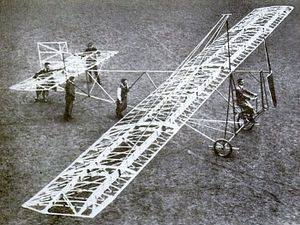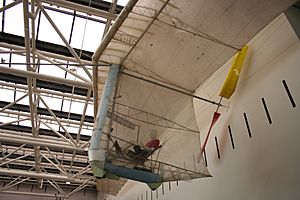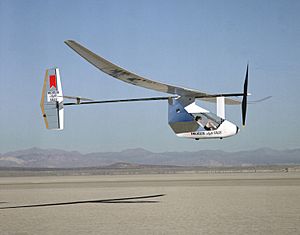Human-powered aircraft facts for kids
A human-powered aircraft (often called an HPA) is an airplane that flies using only the power created by a person. Think of it like a bicycle for the sky! These amazing machines are built as a challenge for engineers and pilots, showing what's possible when humans combine their strength with clever design.
Contents
History of Human-Powered Flight
Early attempts to fly using only human power were very difficult. Airplanes need a lot of power for their weight to get off the ground and stay in the air. Many early designs tried to flap their wings like birds (these are called ornithopters), but they were often too heavy and didn't fly well.
First Tries to Fly
In 1904, a magazine called Scientific American showed a picture of a "bicycle plane" built by Steward Winslow. He tried to fly it, but it didn't work out.
One of the first human-powered planes was the Gerhardt Cycleplane in 1923. It had seven wings! The pilot pedaled like on a bike to turn the propeller. This plane could stay in the air for short times when it was pulled by a car first. It even made a small hop of about 6 meters (20 feet) on its own power.

In 1934, Engelbert Zaschka from Germany built a large human-powered plane. It flew about 20 meters (65 feet) at the Berlin Tempelhof Airport. This plane took off without any help from another vehicle.
Another plane, the HV-1 Mufli, flew in 1935. It flew 235 meters (770 feet) and later even 712 meters (2,336 feet)! However, it was launched using a strong cable, so it wasn't fully human-powered from the start.
In 1937, a team in Italy built the Pedaliante. They hoped to win a prize for flying one kilometer (about 0.6 miles). The plane seemed to fly short distances using only human power. But there was a lot of debate about whether it truly took off on its own. Later, it also used a catapult to launch and flew the one kilometer distance, but it didn't win the prize because of the launch method.
First Official Flights
The first time a human-powered aircraft officially took off and landed using only human power was on November 9, 1961. This was the Southampton University's Man Powered Aircraft (SUMPAC), flown by Derek Piggott. It flew 650 meters (2,130 feet) in its best flight.
Just one week later, the Hatfield Puffin flew for the first time. It was built by employees of a company called de Havilland. The Puffin flew nearly 900 meters (2,950 feet), setting a record that lasted for 10 years! A newer version, Puffin 2, even climbed to 5.2 meters (17 feet) high.
In 1972, the Woodford Jupiter flew even farther, reaching 1,239 meters (4,065 feet).
Kremer Prizes and Amazing Flights
In 1959, a group called the Royal Aeronautical Society started the "Man Powered Aircraft Group." They wanted to encourage people to build human-powered planes. A rich businessman named Henry Kremer offered prizes for successful flights.
In 1973, Kremer increased his main prize to £50,000! This prize was for the first human-powered aircraft to fly a figure-eight course around two markers. This was a much harder challenge because it needed a plane that could be fully controlled.
On August 23, 1977, the Gossamer Condor won the first Kremer prize. It was built by Paul MacCready and flown by Bryan Allen, a cyclist. The plane flew a figure-eight course covering 2.172 kilometers (1.35 miles). It was slow, flying at only about 18 km/h (11 mph), but it used very little power.
The second Kremer prize, worth £100,000, was won on June 12, 1979. Again, it was Paul MacCready's design, the Gossamer Albatross, flown by Bryan Allen. This time, Bryan flew the plane all the way from England to France! This amazing flight covered 35.82 kilometers (22 miles) in 2 hours and 49 minutes.
Speed Records and Longest Flights
A week after the Gossamer Albatross flew across the English Channel, students at the Massachusetts Institute of Technology (MIT) flew their Chrysalis aircraft. It was very easy to control and was flown by many different pilots.
On May 11, 1984, the MIT team won another Kremer prize, this time for speed. Their Monarch-B plane flew a 1.5-kilometer (0.9-mile) course in under three minutes, averaging 32 km/h (20 mph).
The MIT group kept improving their designs. Their MIT Daedalus 88 aircraft set the current world distance record on April 23, 1988. Piloted by Kanellos Kanellopoulos, it flew 115.11 kilometers (71.53 miles) from Crete to Santorini in Greece!

Carrying Passengers
The first time a human-powered plane carried a passenger was on October 1, 1984. Holger Rochelt flew his sister Katrin in the Musculair 1.
Modern Human-Powered Flight
Today, human-powered planes have been built and flown in many countries around the world.
The Royal Aeronautical Society now offers new prizes to encourage more innovation:
- A £50,000 prize for a human-powered plane that can fly a 26-mile (marathon) course in under one hour.
- A £100,000 prize for a "sporting" human-powered plane that can fly in normal weather.
In 2012, the Royal Aeronautical Society started the Icarus Cup. This competition is not just about breaking records. It wants to make human-powered flying a popular sport! The Icarus Cup includes challenges like flying through a slalom course, taking off without help, and landing accurately. It's held every year at Lasham Airfield in Great Britain, where the first human-powered flight happened.
In Japan, Yuta Watanabe has made impressive long-distance flights, including a 60 km (37 mile) flight in 2019 during the Japan International Birdman event.
Types of Human-Powered Aircraft
Airships
Some inventors have built human-powered airships. These aircraft float using gas, like a balloon. Because they get their lift from floating, they need much less effort to move through the air compared to airplanes that rely on wings.
Helicopters and Rotorcraft
It's even harder to build a human-powered helicopter, but some have been successful in short flights.
Ornithopters
An ornithopter is an aircraft that flies by flapping its wings, just like a bird or an insect. On August 2, 2010, Todd Reichert flew a human-powered ornithopter called Snowbird. The pilot sat inside and pumped a bar with his feet to make the wings flap up and down. After being pulled into the air by a car, it flew on its own for almost 20 seconds, covering 145 meters (475 feet).
See also
 In Spanish: Vehículo aéreo de propulsión humana para niños
In Spanish: Vehículo aéreo de propulsión humana para niños
- Human-powered transport
- Solar-powered aircraft
- Zero-emissions vehicle
- Human-powered helicopter
- Controllable slope soaring
- Ornithopter
- List of human-powered aircraft


